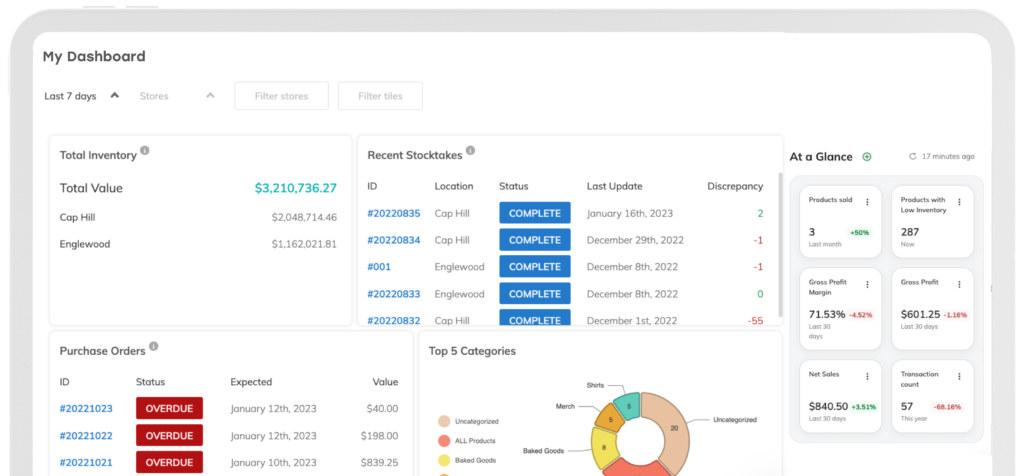
Receiving Inventory 101: Essentials And Tips For New Business Owners
Your most recent order has just arrived. What you do next with those products directly influences efficient operations and customer satisfaction. Receiving inventory is a key step in managing your business’s stock at the heart of your sales operation. The process of accepting and inspecting an inventory shipment is fundamental for new organizations to understand, so you can keep business moving. Below, dive deeper into the steps and best practices for receiving your items, and how it fits into the bigger picture of managing inventory.
Why Do You Have To Receive Inventory?
Stock level accuracy
When you properly receive and verify items, you catch inventory imbalances early on. This ensures the quantities in your system match what’s on your shelves. This accuracy helps you avoid stockouts and overstock situations, so you’re not losing money by overbuying or missing sales because you ran out of an item.

Meeting customer demand
Accurate inventory receiving confirms you have the right products on hand to promptly and completely fill customer orders. This is an important factor in your demand management strategy, which involves predicting and planning for shopper needs to keep your stock levels just right. When you know what items you have in stock, you fulfill orders on time and keep your customers happy and coming back for more.
Power Up
Demand planning is an essential part of running a successful business. Learn how to implement a strategy step-by-step in our blog.
The Newsletter For Small Businesses
Weekly expert insights, industry trends, and inspiring stories designed to help you run your business with confidence.
Quality control and cost savings
The inventory receiving process is a perfect time to check product quality. Catching defects or damages early means you deal with these issues right away, whether that means returning items to the supplier or obtaining replacements. This proactive approach saves you from the headaches and costs associated with customer complaints and returns.
Reducing product losses
Properly documented and organized items prevent losses due to misplacement, theft, or damage. When items are received and stored properly, you know precisely where they’re going and how much of each item is where. This increases your ability to identify missing inventory, thereby protecting your investments.
More efficient warehouse operations
Everything runs more smoothly when your inventory is well-organized, especially your warehouse management system. When you check in and store products in their designated location from the get-go, you improve your business’s spatial management. This makes tracking inventory a much easier process, speeding up order fulfillment and cutting down on labor costs.

Compliance with safety regulations
Following safety regulations is a must for perishable items like food. Proper receiving practices ensure these items are stored under the right conditions and that nothing is left sitting around for extended periods. Following a proper receiving inventory process protects your customers and keeps your business out of regulatory trouble.
Types Of Businesses That Need To Receive Inventory
Traditional retail
Accurate inventory management starts with thorough and documented receiving practices. Whether it’s clothing at a boutique, household goods at a gift shop, or a shipment of side tables to your furniture store, receiving inventory is the starting point for nearly every aspect of your business, from warehousing to shipping.
Manufacturing
It’s not just about finished goods, either. If you use raw or work-in-progress materials to create the products you sell, it’s especially important to carefully receive and inspect your inventory. Verifying the quantities against your purchase orders ensures your manufacturing process runs smoothly and you have the necessary materials on hand to meet customer demand without delays.
Service-based businesses
Even if you don’t sell or make goods, you always have some sort of inventory you need to manage. These could be the tools required to complete a job, like the number of tablets available for customer service representatives, hand drills maintenance technicians can grab for a job, or the catalog of decor items a home stager may use. Receiving, managing, and maintaining those supplies is key to keeping projects on track — and clients satisfied.

Food and beverage
If you run a food service business, receiving inventory isn’t just about stocking shelves — it’s about ensuring the quality and safety of every ingredient that comes out of your kitchen. Whether you’re a caterer or a chocolatier, freshness is paramount, especially for perishable items like meats, dairy products, and produce. Maintaining the integrity of pre-packaged items, such as sauces, canned goods, and snacks, is equally important for consistency and quality.
By carefully inspecting each delivery, you’ll catch any signs of spoilage and prevent bad food from reaching your customers. This attention to detail not only keeps your business compliant with the law, but upholds your reputation for producing and serving high-quality food.
Steps To Receiving Inventory
1. Have your purchase order ready
Your purchase order, known simply as a PO, is your reference document. It details everything you expect to receive, including quantities, descriptions, expected delivery date, and agreed-upon prices. Before your shipment comes in, review the PO to refresh your memory about what you ordered. This preparation helps you stay organized so you know exactly what to look for when your delivery arrives.
Free Template: Purchase Order
Use this template to track your orders, communicate with suppliers more clearly, and keep your shelves stocked.
2. Make sure the received products match your PO
When your shipment’s inventory arrives, it’s time to carefully check the products. Start by comparing the delivery against your PO. Verify that the quantities match and that each item is what you ordered. Inspect for any damage or defects, especially with fragile or perishable items. If you spot any discrepancies or issues, note them immediately. This step on the receiving inventory checklist ensures that you only pay for what you receive and that everything is in good condition.

3. Update inventory counts
This step involves logging the new stock into your inventory system and adjusting the quantities to reflect the additions. Accurate record-keeping at this stage is crucial for maintaining precise inventory levels, which helps in forecasting demand, planning future orders, and avoiding stockouts and excess stock.
4. Store your inventory
The final part of the receiving process is to properly store your inventory. Depending on your products, an efficient inventory storage system could involve placing items in a warehouse, stocking shelves, or storing goods in a temperature-controlled environment. Organize your inventory in a way that makes it easy to locate and retrieve items. This involves methods such as using clear labeling, categorizing similar items together, and implementing a first-in, first-out (FIFO) system for perishable goods.
Automate Building Purchase Orders
Thrive Inventory’s powerful Purchase Order capabilities make ordering inventory at scale easy. Email professionally branded Purchase Orders to your vendors directly in Thrive, streamlining the process for re-ordering products.
Potential Challenges Of Receiving Inventory
You can’t plan for the unexpected, but it’s important to be aware of the factors that might affect your receiving process.
- Supply chain issues. Manufacturing and transportation delays severely impact inventory levels. If, for example, you run a toy and craft store, supplier backlogs of one of your most popular jigsaw puzzles will quickly lead to missed sales opportunities. Building strong relationships with multiple suppliers and making regular communication part of your vendor management strategy helps suppliers better plan their schedules to meet your inventory needs.
- Damaged goods. This common issue leads to stock shortages and customer dissatisfaction. You can’t always prevent items from arriving damaged. However, inspecting all deliveries thoroughly upon arrival and having a clear policy for returning damaged items to suppliers limits the number of these products that reach your customers.
- Inefficient workflows. Slow processing times, misplaced items, and other inefficient procedures lead to delays and errors in receiving inventory. This often results in extended lead times for fulfilling customer orders and increased operational costs due to accidental overstocking or underordering. Streamline your warehouse management system with clear warehouse receiving procedures, staff training, and technology such as barcode scanners.
- Under or overcounted physical inventory. Counting errors during inventory receiving results in discrepancies that affect your stock levels and financial records. Whether you realize you’ve missed or double-counted products, these inaccuracies lead to incorrect ordering decisions and financial misstatements. One of the best ways to avoid major issues stemming from counting errors is by conducting regular inventory audits. Implementing double-checking procedures during the inventory receiving process is helpful as well.

Ways To Update Your Inventory Counts
Using a spreadsheet
This method involves manually entering received quantities and updating stock levels in a program like Excel or Google Sheets. It’s straightforward and accessible if you’re running a smaller business or are just getting started. Spreadsheets allow for flexibility in how you organize and track your inventory data, and they don’t require specialized software. The drawback is that manual entry can lead to human error. Additionally, as new sales occur in real time, your spreadsheet becomes out of date until you’re able to make your next update.
Manually using an inventory management system
An inventory management system involves logging in, locating the received items within the program, and manually adjusting your stock levels during inventory replenishment. It provides plenty of structure and organization for tracking inventory and comes with features like batch updates, inventory history tracking, and integration with other business systems.
Inventory management systems make automated reporting possible
For more efficient and accurate inventory updates, using a barcode scanner with your inventory management system is highly effective. This approach allows you to scan barcodes on received items, instantly updating stock levels in your inventory management system. It minimizes human error associated with manual data entry and accelerates the inventory receiving process. This method is particularly beneficial if your business has a large inventory or frequent stock movement.
Keep Your Shelves Stocked With Thrive Inventory
When products hit your receiving deck, use a barcode scanner and your Purchase Order in Thrive Inventory to count new stock. Thrive Inventory will automatically update stock counts across all your sales channels.
How To Smoothly Receive Inventory
Get in the habit of documentation
Creating a standard operating procedure (SOP) for an efficient inventory receiving process is key. Write down step-by-step instructions on how to receive and inspect inventory. Train your staff thoroughly on this SOP to ensure everyone follows the same method. Consistency minimizes errors, avoids inventory discrepancies, and speeds up the receiving process.

Keep your area tidy
Maintaining a clean and organized receiving area is crucial for overall warehouse efficiency. Designate specific areas for incoming shipments, inspection, and storage. Keep pathways clear and use shelves or bins to temporarily store received items. Store inventory in an organized manner and document where every item goes. A clutter-free space reduces the risk of misplaced items and streamlines inventory handling.
Create a feedback loop
Create a culture of continuous improvement. Regularly solicit feedback from your employees involved in the receiving process. They’ll have insights into bottlenecks or inefficiencies that interfere with smooth inventory operations. Use this feedback to tweak your SOP, update workflows, or implement new tools that enhance accuracy and speed.
Bring In The Benefits Of The Receiving Process
Receiving inventory is more than moving items from boxes to your storage shelves. It’s an important part of ensuring your business operates smoothly and meets customer demands. From checking deliveries for quality to updating inventory records, the many pieces of the receiving process help you maintain accurate stock counts and keep up with customer demand.
The Only Inventory System That Actually Helps You Run A Healthy Business
Thousands of customers all over the world use Thrive Inventory to run a healthy business.
Thrive Inventory gives you control over all your inventory, sales channels, and metrics, allowing you to make the right decisions at the right time.
Keep Reading

The Newsletter For Small Businesses
Weekly expert insights, industry trends, and inspiring stories designed to help you run your business with confidence.
Try Thrive Inventory For Free
Add Thrive Inventory to your business and maximize your potential. With powerful and easy-to-use products, it’s time to take control of
your business and see what you can do with Thrive.




